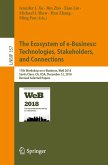Digital platforms hold significant economic value, enriching various industry sectors. While they are pivotal in driving value creation and capture, it is not solely their technological prowess that underpins their economic significance. Rather, their effectiveness lies in their integration within business ecosystems. In this study, Tobias Wulfert examines digital platforms in the context of e-commerce through five lenses:
· Enterprise architecture
· Boundary resources
· Application lifecycle
· Dynamic capabilities
· Value creation
This analysis focuses on different e-commerce platform types, developing an architectural framework and a taxonomy for classification. The author also delineates e-commerce ecosystem architectures, emphasizing the role of platforms as central components and the involvement of peripheral ecosystem participants. He explores boundary resources as crucial interfaces between platforms and ecosystem participants. He further suggests a reference procedure model for the management of these boundary resources. Furthermore, he delves into the dynamic capabilities necessary for effective ecosystem orchestration, identifying configurations of dynamic capabilities that can confer sustainable competitive advantages.
About the author
Tobias Wulfert is a research associate at the Chair of Business Informatics and Integrated Information Systems at the University of Duisburg-Essen. His research projects are concerned with digital platforms in digital transformation and electronic commerce.
· Enterprise architecture
· Boundary resources
· Application lifecycle
· Dynamic capabilities
· Value creation
This analysis focuses on different e-commerce platform types, developing an architectural framework and a taxonomy for classification. The author also delineates e-commerce ecosystem architectures, emphasizing the role of platforms as central components and the involvement of peripheral ecosystem participants. He explores boundary resources as crucial interfaces between platforms and ecosystem participants. He further suggests a reference procedure model for the management of these boundary resources. Furthermore, he delves into the dynamic capabilities necessary for effective ecosystem orchestration, identifying configurations of dynamic capabilities that can confer sustainable competitive advantages.
About the author
Tobias Wulfert is a research associate at the Chair of Business Informatics and Integrated Information Systems at the University of Duisburg-Essen. His research projects are concerned with digital platforms in digital transformation and electronic commerce.
Dieser Download kann aus rechtlichen Gründen nur mit Rechnungsadresse in A, B, BG, CY, CZ, D, DK, EW, E, FIN, F, GR, HR, H, IRL, I, LT, L, LR, M, NL, PL, P, R, S, SLO, SK ausgeliefert werden.









